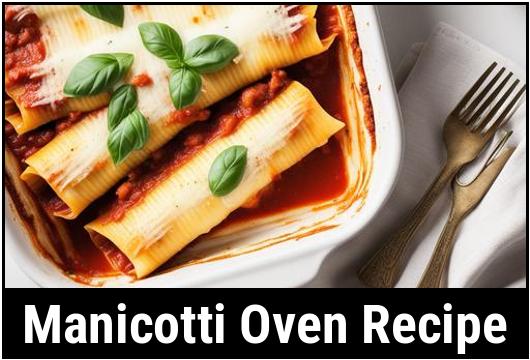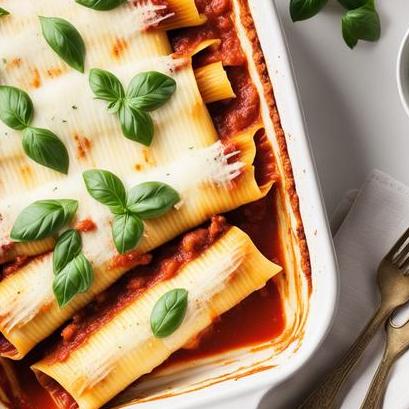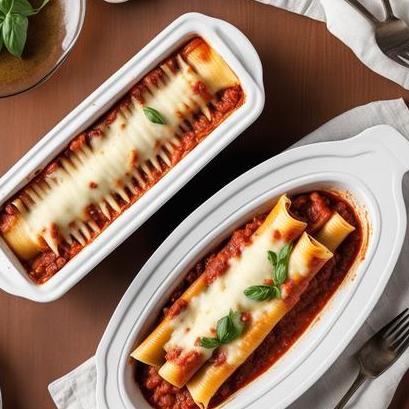
The Art And Science Of Manicotti: Elevate Your Culinary Skills With This Exquisite Oven Recipe
If you are a food enthusiast, eager to embark on a culinary adventure that will delight your taste buds and impress your friends and family, look no further than the delectable world of manicotti. This timeless Italian dish, consisting of pasta tubes filled with a variety of savory ingredients and baked to perfection, is a true embodiment of comfort and gastronomic delight. In this comprehensive article, we will dive into the food science, culinary details, selection, cleaning, preparation, tips, variations, doneness checks, potentially disastrous mishaps of overcooking and undercooking, and finally, we’ll provide you with an outstanding manicotti oven recipe that will make you a hero in the kitchen. So, roll up your sleeves, let’s explore the art of making manicotti!
Food Science: Understanding the Pasta Tubes
Manicotti is traditionally made using large pasta tubes, which act as vessels for the flavorful fillings. These pasta tubes are typically smooth, cylindrical, and made from durum wheat semolina, providing them with a distinct chewy texture when cooked to perfection. Its tubular shape allows for easy stuffing and also ensures that the filling remains intact during the baking process.
Culinary Details: Selecting and Cleaning the Perfect Pasta Tubes
To fulfill our mission of creating an exceptional manicotti dish, it is crucial to choose the right pasta tubes. When selecting your manicotti, opt for tubes with a diameter of around 1 inch and a length of approximately 3-4 inches. This size ensures that the tubes can efficiently hold a generous amount of filling without becoming overstuffed.
Before preparing your manicotti, a significant culinary detail involves cleaning the pasta tubes. As with any pasta, ensure the tubes are rinsed with cool water after cooking to remove any residual starch. This step helps to prevent the noodles from sticking together and provides a clean canvas for the delightful flavors that lie ahead.
Preparation: Assembling the Perfect Manicotti

Filling Options
One of the most delightful aspects of manicotti lies in its versatility. The filling options are limited only by your imagination. Traditionally, ricotta cheese combined with herbs and spices, such as basil and oregano, creates a creamy and flavorful foundation. However, you can venture beyond tradition and experiment with other ingredients like spinach, ground meat, mushrooms, or a combination of these. Embrace your creativity and customize your manicotti to suit your preferences or surprise your guests with unexpected flavor combinations!
Filling Techniques
When it comes to filling the pasta tubes, you have two primary techniques at your disposal: piping and spooning. Piping involves using a piping bag or a resealable plastic bag with the corner snipped off to inject the filling into the tubes smoothly. Meanwhile, spooning entails using a spoon to carefully stuff the filling into the pasta tubes. Both techniques yield wonderful results, so choose the method that feels most comfortable for you.
Tips for Assembly
To ensure ultimate manicotti perfection, follow these tips during the assembly stage:
-
Precook the Pasta: Due to the longer cooking time in the oven, precooking the pasta tubes is essential to achieve just the right texture. Cook the pasta until al dente, allowing it to retain a slight firmness as it will soften further during baking.
-
Generously Fill the Tubes: Stuff each pasta tube generously to create a flavorful and satisfying bite. Do not hesitate to overstuff slightly, as the filling will settle and compact during baking.
-
Keep the Filling Moist: Prevent dryness by ensuring your filling is adequately moist. This can be achieved through the addition of grated cheese, beaten eggs, or even a spoonful of tomato sauce or cream.
-
Handle with Care: Manicotti can be delicate, so handle them gently throughout the process to avoid any tearing or breaking of the tubes.
Doneness Checks: How to Know When Your Manicotti is Perfectly Cooked

While cooking, it’s crucial to keep an eye on your manicotti to ensure they reach the ideal level of doneness. Here are a few signs to look out for:
-
Golden-Brown Cheesy Crust: When the manicotti is baked to perfection, a beautiful golden-brown crust forms on top, enticing the taste buds and offering a delightful crunch.
-
Bubbling Sauces: As the manicotti bakes, the sauce surrounding the pasta tubes should bubble gently, indicating the heat has thoroughly penetrated the dish.
-
Firm yet Tender: Taste your manicotti to ensure the pasta is tender but not overcooked. The perfect manicotti should have a slight bite to it, known as "al dente," indicating it’s cooked just right.
The Recipe: An Outrageously Delicious Manicotti Oven Recipe

To round off this comprehensive guide, we present you with a fantastic manicotti oven recipe that will certainly satisfy and impress.
Ingredients
-
8-10 large manicotti pasta tubes
-
2 cups ricotta cheese
-
1 cup mozzarella cheese, shredded
-
1/2 cup Parmesan cheese, grated
-
1 egg, beaten
-
1/4 cup fresh basil, chopped
-
1/4 cup fresh parsley, chopped
-
2 cups marinara sauce
-
Salt and pepper to taste
Instructions
-
Preheat your oven to 375°F (190°C). Grease a baking dish with a light coating of olive oil.
-
Cook the manicotti pasta according to the package instructions, ensuring it remains slightly undercooked (al dente). Rinse the pasta with cool water after cooking to remove starch and prevent sticking.
-
In a bowl, combine the ricotta cheese, mozzarella cheese, Parmesan cheese, beaten egg, chopped basil, and parsley. Season with salt and pepper, mixing well to create a flavorful filling.
-
Using a piping bag or a spoon, carefully fill each manicotti pasta tube with the ricotta mixture. Place the filled manicotti in the greased baking dish, arranging them side by side.
-
Pour the marinara sauce over the filled manicotti, ensuring they are thoroughly covered. Sprinkle additional shredded mozzarella and grated Parmesan cheese on top for extra indulgence.
-
Cover the baking dish with aluminum foil and bake for approximately 30 minutes. Remove the foil and continue baking for another 10-15 minutes until the manicotti develops a beautiful golden-brown crust.
-
Once cooked, remove the manicotti from the oven and allow them to cool slightly before serving. Serve with a sprinkle of fresh basil or parsley on top for a vibrant touch.
Overcooking and Undercooking: Avoiding Culinary Disasters

While our manicotti oven recipe yields stellar results, it’s important to be aware of overcooking and undercooking pitfalls that could potentially mar your culinary triumph.
Overcooking: Leaving the manicotti in the oven for an excessively long time may result in dried-out pasta tubes and overcooked filling. To prevent overcooking, closely monitor the cooking time, and reduce it slightly if your oven tends to run hot.
Undercooking: On the other hand, undercooking the manicotti may leave you with pasta tubes that are too firm and difficult to chew. Ensure the pasta is cooked until al dente during the precooking stage, and follow the recommended baking time to achieve the perfect balance of tenderness and firmness.
Variations: Embrace Creativity and Tantalize Your Taste Buds
While our recipe provides a classic approach to manicotti, don’t be afraid to experiment and create your own variations to suit your personal preferences. Consider incorporating different types of cheese, adding vegetables like spinach or mushrooms, or even experimenting with seafood or meat fillings. The possibilities are endless, providing endless opportunities for culinary exploration and delight.
In Conclusion
The art of creating manicotti is a deeply gratifying culinary experience where science and creativity intersect. Armed with an understanding of food science, meticulous preparation, attention to details, and a willingness to explore variations, you can achieve manicotti excellence that will leave your guests clamoring for seconds. So, embrace this culinary journey, savor the flavors, and enjoy the gastronomic masterpiece that is manicotti – a dish that embodies the rich heritage and endless possibilities of Italian cuisine.
Sources
FAQS On Manicotti Oven Recipe
What Ingredients Do I Need To Make Manicotti In The Oven?
You will need manicotti pasta, ricotta cheese, mozzarella cheese, Parmesan cheese, eggs, spinach, garlic, crushed tomatoes, Italian seasoning, salt, and pepper.
How Long Do I Need To Cook Manicotti In The Oven?
You should bake manicotti in the oven for about 40-45 minutes, or until the pasta is tender and the cheese is melted and bubbly.
Can I Prepare The Manicotti Ahead Of Time And Bake It Later?
Yes, you can prepare the manicotti ahead of time and refrigerate it until you are ready to bake it. Just cover it with plastic wrap to prevent drying out.
Can I Freeze Manicotti Before Baking It?
Yes, you can freeze uncooked manicotti. Prepare the dish as instructed, then cover it tightly with aluminum foil and freeze for up to 3 months. When ready to bake, thaw in the refrigerator overnight and then bake as directed.
Can I Add Meat To The Manicotti Filling?
Yes, you can add cooked ground beef or Italian sausage to the cheese and spinach mixture for a heartier filling. Just make sure to brown the meat thoroughly and drain off any excess fat before adding it to the manicotti.



